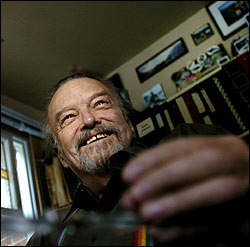
|
| SIMON HAYTER / TORONTO STAR FILE PHOTO |
| Bob Hunter spent $20,000 for alternative cancer treatment at a Mexican clinic
whose owner has had run-ins with U.S. authorities over unapproved medicine. |
|
Mixed reaction to Hunter's search for cure
JUDY STEED
The
story I wrote last week about Bob Hunter, co-founder of Greenpeace,
dealing with a diagnosis of terminal prostate cancer, elicited a strong
response from readers.A lot of love was generated by those who
admire Hunter's lifelong environmental activism. "May God bless you and
your family," wrote one. "It's good to hear you are feeling
better," said another. "However, I hate to read (such) articles ... How
many men do you think are wishing they could afford to pick up and go
to Mexico for treatment?" That was a common reaction: anger that OHIP
doesn't cover alternative treatments, frustration that the $20,000
Hunter spent for three and a half weeks at Hospital Santa Monica in
Tijuana was not an affordable option for most."I found this
story more than interesting," wrote a Toronto man whose prostate cancer
was "discovered in the early stages and was identified as being
confined to the prostate." But "differing medical interpretations of
the biopsy" made his choices more difficult. "The decision-making
process was perhaps the most difficult part of the entire experience
... The circumstances of each case are unique and the individual has to
call the final shot and live with his decision." He chose surgery and,
so far, he's doing well, two years later.Some readers cited
examples of family members recovering from cancer with alternative
treatments, after conventional treatments failed; a few criticized
Hunter's decision to go to Mexico. On this point, the central issue is
Hunter's right to choose. After a five-year process of dealing with
prostate cancer, he found himself at death's door, given a "death
watch" verdict, as Hunter's wife Bobbi put it, by his Toronto doctors.
All they could offer him was chemotherapy, which might keep him alive a
few months longer.When he left for Hospital Santa Monica before
Christmas, he had no appetite and was in terrible pain — the prostate
cancer having spread to his bones; morphine just made him feel sicker. When
he came home, he was pain-free and his appetite had returned. He felt
good. He doesn't know how long it will last. Neither he, nor Kurt
Donsbach, the chiropractor who founded the clinic, make any claims
about "cure." As Hunter told me, "I'm not talking about being `saved.'
We won't know until more time has gone by."Some readers wanted
to find out how to get to the Mexican clinic. Hence a cautionary note:
the story was told from Hunter's point of view; it was not an
investigative piece on the clinic itself. A variety of medical clinics
have sprung up in Mexico, clustered around Tijuana, serving mostly
American cancer patients who come to these places as a last resort. Not
all of them are reputable, according to Donsbach, who scoffs at "coffee
enemas" and similar treatments offered at certain clinics.On the
other hand, as Dr. Fred Hui says, "assuming we have a true, natural
treatment, as long as it's not patentable it will never attract the
financing from pharmaceutical companies to go through the necessary
studies and clinical trials." (It was Hui, a Toronto doctor, who told
Hunter about Hospital Santa Monica. Hui describes himself as an
"open-minded physician.")We've also learned that Donsbach has
had his own battles with U.S. authorities, who he claims have harassed
him for decades for doing nutritional counselling and selling vitamins,
minerals and herbs to treat various ailments. He had to declare
bankruptcy in 1987. And he acknowledges he pleaded guilty to tax
evasion and conspiracy to smuggle "unapproved medicine", and agreed to
"forfeit all money seized — $372,000." The sentence was three years
probation.So: buyer beware. Just as we've recently discovered
that mainstream drugs can cause harm or even death — think hormone
replacement therapy, Vioxx and Celebrex — we realize we live in a world
of few clear-cut answers, especially when it comes to health. In
the last 40 years, despite billions of dollars spent on research and
development — on chemotherapy, radiation and surgery — cancer cures are
still limited, in terms of available data. (Of the many types of
cancer, chemotherapy claims to cure only "about two-thirds of patients
with Hodgkins disease; half with a type of lymphoma; most children with
a type of leukemia; most young men with testicular cancer," according
to Cancer Care Ontario.) The truth is that no one has the
answer to the big question: What causes cancer? We are all guinea pigs.
People die on chemotherapy — indeed, chemotherapy can kill people.Understand
the limitations of medicine. Research your options. Try to deal with
reputable people. Take responsibility for your health. Know that
miracles are rare.Additional articles by Judy Steed › Get the NEW Sunday paper! Save 50% now! |